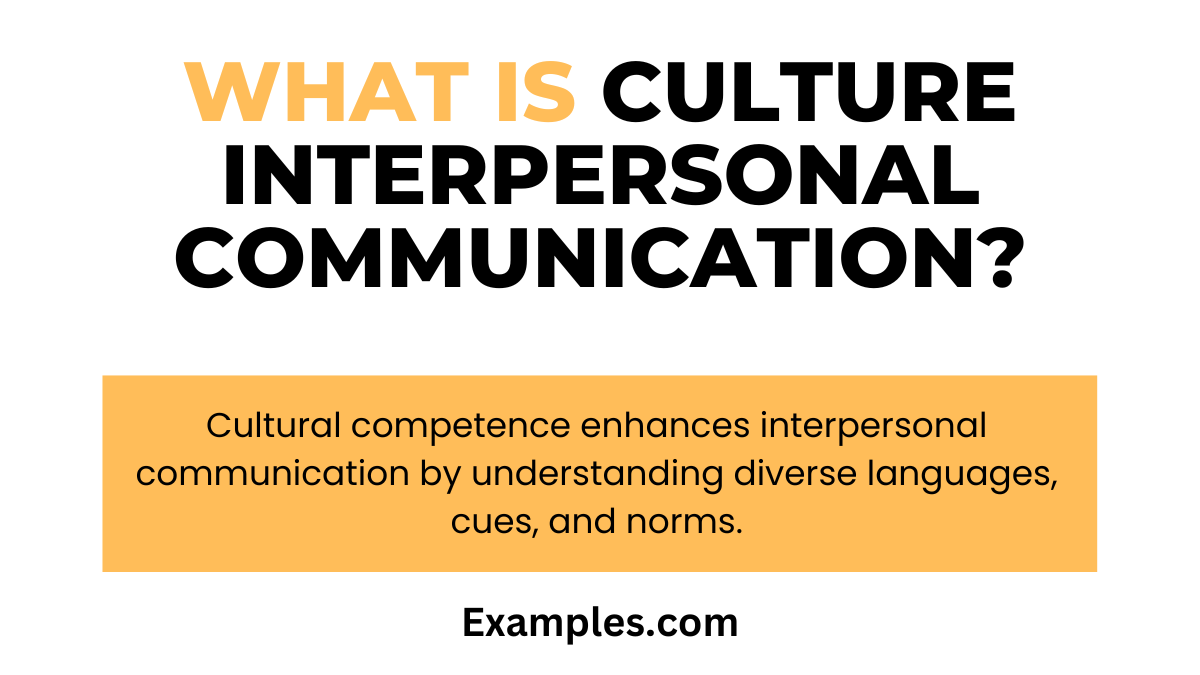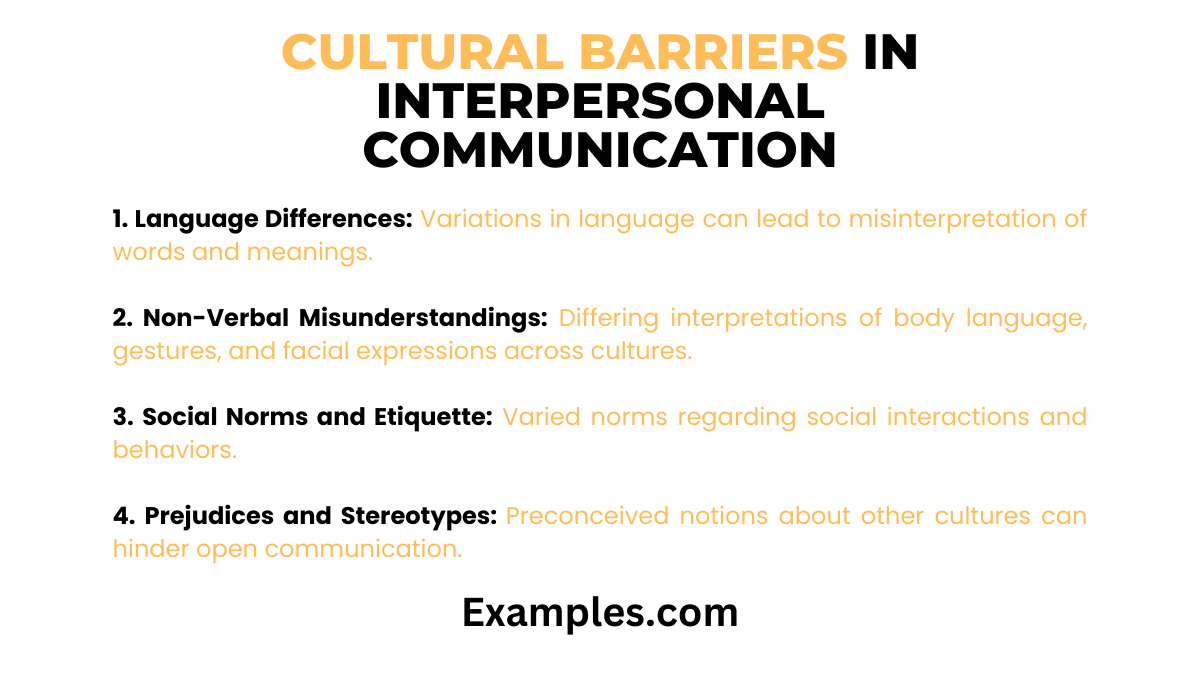Culture Interpersonal Communication
In the realm of interpersonal communication, understanding the influence of culture is crucial, especially in oral communication. Culture shapes how people express themselves, interpret messages, and interact in social contexts. Recognizing these cultural nuances can significantly enhance communication effectiveness. This understanding is particularly important in diverse environments, where assumptions based on one’s own cultural background can lead to misunderstandings. Culturally aware communication involves not only language proficiency but also an appreciation of different communication styles, social norms, and non-verbal cues.
What is Culture Interpersonal Communication?

Culture in interpersonal communication refers to the influence of diverse cultural backgrounds on the way individuals interact and convey information. It encompasses a range of aspects, from language and oral communication styles to non-verbal cues and social norms. Understanding cultural differences is key to effective communication, as it helps bridge gaps and fosters mutual respect and understanding. In today’s globalized world, being culturally competent in communication is essential for personal and professional success, enabling smoother interactions across various cultural contexts.
What are Cultural Barriers in Interpersonal Communication?

Cultural barriers in interpersonal communication arise when cultural differences hinder effective interaction. These barriers, often rooted in diverse cultural norms and languages, can lead to misunderstandings, misinterpretations, and conflicts. Being aware of these obstacles is crucial, especially in today’s globalized environment, where interactions often occur across various cultural backgrounds. Overcoming these barriers requires sensitivity, understanding, and adaptability to foster clear and respectful communication.
Key Cultural Barriers in Interpersonal Communication:
- Language Differences: Variations in language can lead to misinterpretation of words and meanings.
- Non-Verbal Misunderstandings: Differing interpretations of body language, gestures, and facial expressions across cultures.
- Social Norms and Etiquette: Varied norms regarding social interactions and behaviors.
- Prejudices and Stereotypes: Preconceived notions about other cultures can hinder open communication.
- Differing Communication Styles: Variations in directness, formality, and expressiveness in communication.
- Contextual Interpretation: Differences in how high-context (indirect) and low-context (direct) cultures convey and interpret messages.
- Values and Beliefs: Diverse cultural values and beliefs can affect communication priorities and styles.
- Emotional Expression Norms: Different cultural norms for expressing emotions and affections.
- Time Perception: Cultural differences in punctuality and perceptions of time management.
- Power Distance: Variations in hierarchy and authority perception can affect communication dynamics.
Cultural Aspects of Interpersonal Communication
Understanding the cultural aspects of interpersonal communication is crucial for effective interactions in our increasingly globalized world. Culture profoundly influences how we communicate, perceive messages, and interpret behaviors.
- Communication Styles: Different cultures have varying communication styles, ranging from direct to indirect. Some cultures value straightforwardness, while others may prefer more subtle or context-dependent communication.
- Non-Verbal Cues: Body language, eye contact, and gestures vary significantly across cultures. For instance, the meaning of certain gestures can differ, sometimes substantially, between cultures.
- Contextual Communication: High-context cultures rely heavily on implicit communication and context, whereas low-context cultures emphasize explicit verbal information.
- Formality and Hierarchy: The level of formality in communication and the importance placed on hierarchy and respect can differ across cultural boundaries.
- Emotional Expression: Cultures vary in their display of emotions; some encourage open emotional expression, while others may value emotional restraint.
- Language and Idioms: Language barriers and the use of idioms can lead to misunderstandings. Effective communication often requires sensitivity to these linguistic differences.
- Personal Space and Physical Contact: Cultural norms dictate acceptable levels of personal space and physical touch, which can impact interpersonal interactions.
- Time Perception: Different cultures have varying perceptions of time and punctuality, which can influence communication and scheduling.
- Listening Habits: Active listening and the role of silence in conversation can differ, with some cultures valuing silence more than others during discussions.
- Cultural Adaptability: Being adaptable and open to different communication styles is key to successful cross-cultural interactions.
What is the Intersection of Culture and Interpersonal Communication?
Key Points at the Intersection of Culture and Interpersonal Communication
- Cultural Influences on Communication Styles: Culture shapes how individuals express themselves and interpret verbal and non-verbal cues in communication, influencing styles and preferences.
- Impact on Perception and Interpretation: Cultural backgrounds play a crucial role in how messages are perceived and interpreted, affecting understanding and responses in interpersonal interactions.
- Facilitation of Cross-Cultural Understanding: Awareness of the intersection between culture and communication is essential for effective cross-cultural interactions, reducing misunderstandings and fostering respect in diverse settings.
How Culture Affects Interpersonal Communication
Culture significantly influences interpersonal communication, shaping how individuals perceive, interpret, and convey messages. Understanding these cultural impacts is crucial for effective communication, particularly in diverse environments.
- Language and Dialects: Language is a primary tool in oral communication. Different cultures have unique languages or dialects, which can lead to misunderstandings or misinterpretations if not properly managed.
- Non-Verbal Communication: Cultural norms dictate non-verbal behaviors like gestures, facial expressions, and eye contact. What is considered polite or rude non-verbal behavior can vary greatly between cultures.
- Communication Style: The directness of communication varies across cultures. Some cultures value straightforward, explicit verbal communication, while others might prefer a more indirect or subtle approach.
- Contextual Communication: High-context cultures rely on the context and non-verbal cues for meaning, whereas low-context cultures prioritize direct and clear verbal messages.
- Concepts of Time: Time perception affects communication styles. Some cultures view time as linear and are punctual and deadline-oriented, whereas others have a more fluid perception of time.
- Social Hierarchies and Power Distance: Some cultures have strict hierarchical structures that dictate communication protocols, especially in professional settings, impacting how information is shared and received.
- Emotional Expressiveness: The degree of emotional expression that is acceptable varies. Some cultures encourage open emotional expression, while others may view it as unprofessional or inappropriate in certain contexts.
- Values and Beliefs: Deep-rooted cultural values and beliefs can influence priorities, attitudes, and the way messages are conveyed and received in interpersonal interactions.
- Listening Styles: Active listening and the role of silence can be interpreted differently. In some cultures, silence is a sign of respect and contemplation, while in others, it might be seen as disinterest or disapproval.
- Conflict Resolution Styles: Attitudes towards conflict and methods of resolution vary. Some cultures may address conflicts directly, while others might avoid confrontation to maintain harmony.
- Ethnocentrism: A lack of cultural awareness can lead to ethnocentrism, where one’s own culture is seen as the standard to which others should adhere, hindering effective cross-cultural communication.
- Stereotypes and Prejudices: Misconceptions about other cultures can lead to biased communication, creating barriers in understanding and collaboration.
Cultural factors play a critical role in shaping interpersonal communication. Recognizing and adapting to these cultural nuances is essential for successful and meaningful interactions in an increasingly interconnected world.
Understanding and adapting to cultural nuances in interpersonal communication is vital for effective interaction. Embracing diversity, respecting different communication styles, and being aware of non-verbal cues are key to bridging cultural gaps. This awareness enriches connections, enhances understanding, and fosters successful relationships in both personal and professional spheres.



